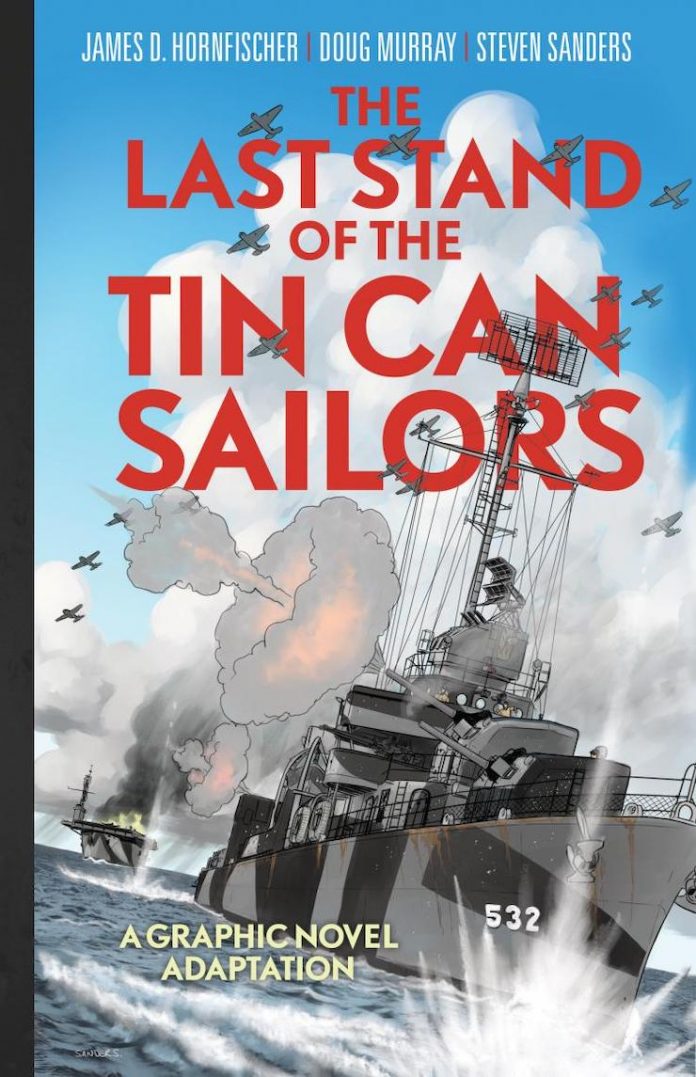
The Last Stand of the Tin Can Sailors; The extraordinary World War Two story of the United States Navy’s finest hour. By James D Hornfisher; adapted by Doug Murray; drawn by Steven Saunders; coloured by Matte Soffe; lettered by Rob Steen. Naval Institute Press, Annapolis, 2021
Reviewed by Tim Coyle
Upon opening the electronic copy of The Last Stand of the Tin Can Sailors, I was instantly transported to my baby boomer childhood, as this is a war comic and is an adaptation of the original title published in 2004.
The aftermath of World War 2 brought a plethora of war movies, veterans writing their memoires and first-generation historians researching for official histories. Practically all adults below the age of 50 had served in the armed forces or war industries. It was also a period, before widespread availability of television, in which young people’s imaginations were stimulated by the art and intimacy of the comic book. Chief among the comic offerings was the war comic genre depicting tall tales and true of the recent world conflict.
The book tells the story of the Battle of Samar, fought in October 1944. Allied forces landing on the Philippines island of Leyte were covered by Admiral Halsey’s Third Fleet. However, the Halsey force was lured away by a Japanese feint and set off in pursuit. The Japanese deception exposed the beachhead allowing a second Japanese force, led by the battleship Yamato, to steer through the centre of the island chain with the aim of destroying the landing force.
The only USN force remaining was Taffy 3, comprising six escort carriers, three destroyers and four destroyer escorts. The Japanese Centre Force comprised four battleships, six heavy cruisers, two light cruisers and 11 destroyers. How the action ensued is dramatically depicted in a triumph of the comic art.
Unlike many of the ‘old’ comics, Tin Can Sailors is in full colour; the imagery stark and dramatic. Some examples: the Japanese flagship, Yamato, is drawn in some panes at an angle at sea level in darkness maximising its menace. Full page drawings show Yamato firing a broadside of 18- inch shells, torpedo spreads fired by the US destroyers and the skies full of USN Wildcats and Avengers among tropical cloud formations.
A Wildcat pilot, landing at the incomplete Tacloban air base with low fuel and no ammunition, commandeered the airbase at pistol-point when the army commander refused to rearm him and his colleagues. The comic art form depicts the incident succinctly by the pilot drawing his gun and ordering his navy pilot colleague to remove the army officer. This is only one of the many scenes whereby the comic format enhances the action drama.
All the renderings are impressive in technical detail and the drawn faces of the personnel are replete with all the emotional expressions of men under the stress of desperate action.
The Last Stand of the Tin Can Sailors will likely appeal to several classes of readers: a new generation of action comic enthusiasts, gamers and naval history buffs. The latter may compare the comic depictions with the written histories to further bring to life the heroisms displayed in the battle. My childhood alter ego would probably approve of The Last Stand of the Tin Can Sailors.



